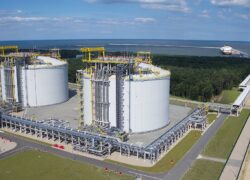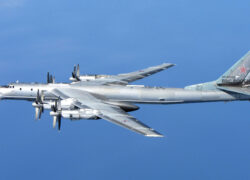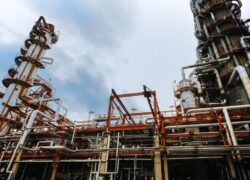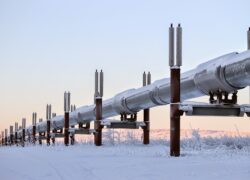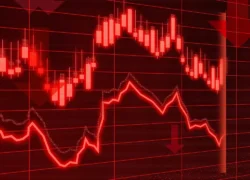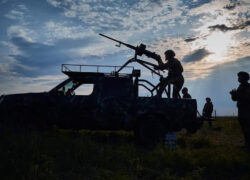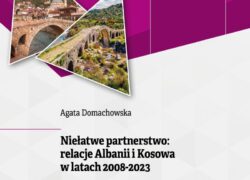The lack of success in the counteroffensive has sparked a lively debate in Ukraine regarding the situation on the front and the overall state of the country. The prolonged war of attrition is advantageous for the Russian Federation, which has the necessary resources to continue its aggression. Russia counts on weakening Kyiv as well as tiring its allies and reducing the scale of support. The coming year may be decisive for the fate of the Russian-Ukrainian war.
The counteroffensive and its effects. The approaching winter, leading to a decrease in the intensity of military operations, encourages Ukrainian politicians and military officials to assess the progress of the Ukrainian counteroffensive in the south and east of the country. In the context of this debate, the interview of the Chief Commander of the Ukrainian Armed Forces, Gen. Valerii Zaluzhny, for the British magazine “The Economist” on 1 November 2023, gained significant attention. He emphasizes the threat associated with the slowdown of the Ukrainian counteroffensive in the context of the ongoing war. Gen. Zaluzhny, referring to the modest successes of the Ukrainian army, highlighted that they are a result of the Russian army’s superiority in many key areas of warfare, including the air force, the number of soldiers, and mobilization potential. The challenges posed by extensive fortification systems and minefields, sometimes reaching widths of 15-20 kilometres, are also not insignificant. Clearing them is extremely troublesome due to the risk of shelling and the possibility of the opponent using overlay mine systems. Additionally, the use of counter-battery systems by Ukrainian forces hinders the increasingly effective use of Russian electronic warfare systems that disrupt GPS signals, reducing the accuracy of GPS-guided missiles and rockets and impeding drone operations. Russians have good battlefield awareness, missile systems, and drones capable of reaching practically any point on Ukrainian territory. This not only complicates the concentration of forces before a potential attack on Russian positions but also hinders the training of reserves deep within the country.
The problem is also the Russian dominance in many areas as well as the consistently increasing efficiency of the Russian arms industry and, despite sanctions, significant financial reserves. Ukraine is not able to independently confront the aggression of the Russian Federation and is currently dependent on international assistance, primarily from the United States. Thanks to external military support and the involvement of the Ukrainian army and society, Russian attacks are being repelled.
In his essay attached to the interview, Gen. Zaluzhny explains that the lack of success in the Ukrainian offensive is not due to leadership mistakes but is a consequence of problems with the rapid supply of equipment from the West. Without clear technological superiority, achieving dominance on the battlefield is not possible, especially since the Russians continuously adjust their tactics to the current situation. The lack of delivery of long-range missile systems allowed Russia to create fortifications (the so-called Surovikin Line). Meanwhile, delays in the delivery of modern multirole combat aircraft will allow the Russian army to expand its air defence system based on the S-400 missile system, which will be able to counter the use of these aircraft on the front line.
Without breaking Russian dominance in the air, accelerating the demining process, improving the effectiveness of artillery and counter-battery fire, creating and training reserves, and improving the efficiency of electronic warfare systems, a breakthrough on the battlefield will be impossible. This could lead to stabilizing the front line, which would be disadvantageous for Ukraine.
Western doubts. During his September visit to Washington, President Zelensky was coldly received by some politicians, mainly Republicans. He was prevented from addressing Congress, and uncomfortable questions arose about the counteroffensive, reform issues, and, above all, the fight against corruption. The change in the attitude of some American elites is linked to political manoeuvring ahead of the US presidential elections. President Zelensky tried to persuade the audience that the USA “gives their money, and we give our lives,” but it did not resonate with Republicans, who demanded the exclusion of aid for Ukraine from next year’s budget. Additionally, the attack by Islamic fundamentalists from Hamas on Israel focused the attention of the American public on the situation in the Middle East (“IES Commentaries”, No. 990).
Another attempt to allocate funds for Ukraine was the aid package for US allies proposed by President Joe Biden on 20 October 2023, already after the Hamas aggression against Israel, which amounted to USD 105 billion and included, among other things, funds for Israel, support for border services on the Mexican-American border, and assistance for Ukraine in the amount of USD 61 billion. The US president described it as a “wise investment” that would positively impact American security for generations. However, this argument did not convince Republicans, who demanded separate consideration of aid for Israel and Ukraine. In the temporary financial law, replacing the budget and valid until early 2024, no funds were allocated for assistance to either Ukraine or Israel.
Unofficially, among some Western politicians, the view that Ukraine is unable to militarily defeat the Russian Federation is gaining popularity, so diplomatic options need to be considered. However, it should be emphasised that both the President of Ukraine and the overwhelming majority of the Ukrainian population are opposed to any concessions to Russia. According to surveys by the Kyiv International Institute of Sociology (KIIS) in September 2023, 87% of respondents are not willing to make any territorial concessions to Russia. Moreover, as key Ukrainian political and military decision-makers highlight, a ceasefire could serve the Kremlin by enabling it to gain time, gather the necessary resources, and resume fighting at the most opportune moment.
The key problem, both for the European Union and the United States, is the fear of escalating the conflict. This leads to a limitation of military aid to Ukraine, allowing it to “survive” but not to achieve victory. Additionally, EU member states do not always fulfil promises regarding arms deliveries. This was the case with, among others, France and Germany. Ukraine is also counting on the delivery of German long-range Taurus missiles. Furthermore, the European Union has failed to increase the supply of artillery ammunition to a million units annually, and it is uncertain whether this will be possible in the near future.
War of Attrition: Dilemmas of Ukrainian Politics. In the interview and essay by Gen. Zaluzhny published in “The Economist”, the main concern was primarily the threat of the Russian-Ukrainian war turning into a positional war, best known from World War I on the Western Front. However, at the same time, another article appeared in the influential magazine “Time” (30 October 2023), in which the statements of anonymous advisors to Zelensky regarding defeatist moods around the president, his lack of will for peace talks with the Russian Federation as well as problems with corruption (including in the Ministry of Defence) and difficulties related to mobilization, stirred the greatest controversy. One anonymous advisor was reported to have said that even if Ukraine received all the equipment it asked for from the West, there were no soldiers capable of operating it.
In an interview for Radio Svoboda on 31 October 2023, Mykhailo Podolak, an advisor to the head of the Ukrainian President’s Office, disputed the claims in the “Time” article. He suggested that one of the anonymous sources of the author, Simon Shuster, could be the scandalous former advisor to the head of the Ukrainian President’s Office, Oleksiy Arestovych, who accused Zelensky of dictatorial tendencies and announced his candidacy in the upcoming presidential elections. However, Shuster unequivocally stated that he received the information from active advisers of the president. The Secretary of the National Security and Defence Council of Ukraine (RNBO), Oleksiy Danilov, emphasised that Ukraine is conscripting a steady number of people but does not rule out problems with replenishing shortages on the front over time. On the same day, the head of the Ukrainian President’s Office, Andriy Yermak, during a speech at the Hudson Institute in Washington on 13 November 2023, called on Ukraine’s allies, reminding them that the next year will be decisive in terms of the fate of the war. Therefore, it is necessary to intensify sanctions against Russia and increase assistance to Ukraine. At the same time on the same day, the head of the Main Intelligence Directorate of the Ministry of Defence (HUR), Kyrylo Budanov, stated that the war could be extremely long because Russia is not ready for peace talks with Ukraine and possesses significant strategic reserves.
President Biden, Gen. Zaluzhny, and President Zelensky, in their statements, emphasise that the attack on Israel and the Russian aggression against Ukraine are examples of aggression by anti-democratic forces seeking to change the international order. Additionally, Gen. Budanov and the President of Ukraine highlight that the lack of rapid support for Ukraine could result in the conflict spreading to other areas. On 10 October 2023, Zelensky accused Russia of supporting Hamas in the context of its aggression against Israel, and on 16 November in a conversation with African journalists, he hinted that Russia may soon seek to destabilize the Balkans and Moldova, exploiting the world’s focus on the situation in the Middle East.
Conclusions
The interview and essay by Gen. Zaluzhny, combined with the limited successes of the Ukrainian counteroffensive, have sparked a lively discussion in Ukraine about the future of the war and the potential transition to a positional phase with all its consequences. At the same time, Ukraine is currently facing the threat of losing American aid, which is partly a political manoeuvre between the Republican and Democratic camps ahead of the US presidential elections. Therefore, Ukrainian politicians, led by President Zelensky, are trying to convince Western politicians and societies to continue assisting Ukraine. This is becoming increasingly challenging because global attention is now focused on the situation in the Middle East, and polls in the USA and certain EU countries confirm gradually decreasing public support for such actions. Without significant assistance from the West, Ukraine is unable to continue effectively defending against Russian aggression. However, the fears of some Western countries about the escalation of the conflict hinder the increase in military support. The problem is also that the resources of some allied countries are insufficient to continue aid at the current level, and the production of weapons is unable to meet the needs of the Ukrainian army. Without a significant change in the West’s strategy towards Russia’s aggressive posture, without a clear increase in comprehensive support, Ukraine may not be able to continue the prolonged war of attrition, the consequences of which may extend far beyond the Eastern European region.



